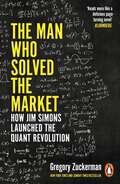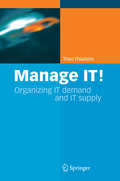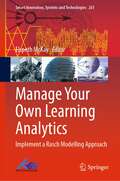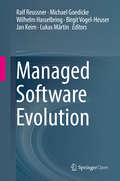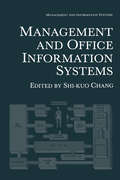- Table View
- List View
The Man Who Solved the Market: How Jim Simons Launched the Quant Revolution SHORTLISTED FOR THE FT & MCKINSEY BUSINESS BOOK OF THE YEAR AWARD 2019
by Gregory ZuckermanSHORTLISTED FOR THE FT AND MCKINSEY BUSINESS BOOK OF THE YEAR AWARD 2019'Reads more like a delicious page-turning novel...Put it on your holiday gift list for your favourite hedge-fund honcho' BloombergJim Simons is the greatest moneymaker in modern financial history. His record bests those of legendary investors, including Warren Buffett, George Soros and Ray Dalio. Yet Simons and his strategies are shrouded in mystery. The financial industry has long craved a look inside Simons's secretive hedge fund, Renaissance Technologies and veteran Wall Street Journal reporter Gregory Zuckerman delivers the goods. After a legendary career as a mathematician and a stint breaking Soviet codes, Simons set out to conquer financial markets with a radical approach. Simons hired physicists, mathematicians and computer scientists - most of whom knew little about finance - to amass piles of data and build algorithms hunting for the deeply hidden patterns in global markets. Experts scoffed, but Simons and his colleagues became some of the richest in the world, their strategy of creating mathematical models and crunching data embraced by almost every industry. As Renaissance became a major player in the financial world, its executives began exerting influence on other areas. Simons became a major force in scientific research, education and Democratic politics, funding Hilary Clinton's presidential campaign. While senior executive Robert Mercer is more responsible than anyone else for the Trump presidency, placing Steve Bannon in the campaign, funding Trump's victorious 2016 effort and backing alt-right publication Breitbart. Mercer also impacted the success of the Brexit campaign. For all his prescience, Simons failed to anticipate how Mercer's activity would impact his firm and the world. In this fast-paced narrative, Zuckerman examines how Simons launched a quantitative revolution on Wall Street, and reveals the impact that Simons, the quiet billionaire king of the quants, has had on worlds well beyond finance.
Manage IT as a Business
by Bennet Lientz Lee LarssenMany IT projects fail to deliver the benefits to the business that were promised. Yet IT managers and staff work hard to meet the needs of the business: Systems are put in place; network operations are reliable and stable. The cause is usually a misalignment of IT with the business. In this book, Bennet Lientz and Lee Larssen present over 200 specific, practical guidelines and steps that show how to: align IT and the business, develop methods that make IT more proactive in helping the business, more effectively manage vendors, avoid negative surprises, ensure that more projects are completed on time and within budget, among other things. The techniques in this book have been implemented in over 60 organizations around the world and in over 20 different industries, and the authors include several examples in each chapter to illustrate their points. Follow these proven recommendations to manage IT as a business that adds value to the company.
Manage IT as a Business: How To Achieve Alignment And Add Value To The Company
by Bennet Lientz Lee LarssenMany IT projects fail to deliver the benefits to the business that were promised. Yet IT managers and staff work hard to meet the needs of the business: Systems are put in place; network operations are reliable and stable. The cause is usually a misalignment of IT with the business. In this book, Bennet Lientz and Lee Larssen present over 200 specific, practical guidelines and steps that show how to: align IT and the business, develop methods that make IT more proactive in helping the business, more effectively manage vendors, avoid negative surprises, ensure that more projects are completed on time and within budget, among other things. The techniques in this book have been implemented in over 60 organizations around the world and in over 20 different industries, and the authors include several examples in each chapter to illustrate their points. Follow these proven recommendations to manage IT as a business that adds value to the company.
Manage Partitions with GParted How-to
by Curtis GedakThis book is a practical, task-based, step-by-step tutorial that starts simple with identifying disk device partitions, and culminates with advanced tasks such as preparing for new operating systems. Are you a computer enthusiast who is looking forward to learn how to effectively use your disk space through disk partitions to maximize your computer's potential? Then this book is for you.
Manage Software Testing
by Peter Farrell-VinayWhether you are inheriting a test team or starting one up, Manage Software Testing is a must-have resource that covers all aspects of test management. It guides you through the business and organizational issues that you are confronted with on a daily basis, explaining what you need to focus on strategically, tactically, and operationally. Using a
Manage Your Life with Outlook For Dummies
by Greg HarveyAn all-new guide that unlocks the secrets of greater Office 2007 productivity-a must-have for power users and everyone who would like to work more efficiently Offers scores of tips, tricks, and techniques to boost productivity with the programs people use every day-Word, Outlook, Excel, and PowerPoint Topics covered include dealing effectively with e-mail, effectively managing files, using and creating templates, reusing and remixing content, sharing and reviewing content, and efficiently managing time and scheduling The CD-ROM and companion Web site offer podcasts of key productivity tips from the book Note: CD-ROM/DVD and other supplementary materials are not included as part of eBook file.
Manage Your Life with Outlook For Dummies
by Greg HarveyAn all-new guide that unlocks the secrets of greater Office 2007 productivity-a must-have for power users and everyone who would like to work more efficiently Offers scores of tips, tricks, and techniques to boost productivity with the programs people use every day-Word, Outlook, Excel, and PowerPoint Topics covered include dealing effectively with e-mail, effectively managing files, using and creating templates, reusing and remixing content, sharing and reviewing content, and efficiently managing time and scheduling The CD-ROM and companion Web site offer podcasts of key productivity tips from the book Note: CD-ROM/DVD and other supplementary materials are not included as part of eBook file.
Manage Your Own Learning Analytics: Implement a Rasch Modelling Approach (Smart Innovation, Systems and Technologies #261)
by Elspeth McKayThis book sheds light on the practice of learning analytics, illuminating how others approach their data analysis. At the beginning of the book, a ‘prescriptive learning analytics planning model’ gives straightforward instructions for people to follow. This book is organized into ten chapters, falling into four topical sections: Managing Learning Analytics (overview, instructional systems design (ISD), instructional design, and planning data analysis); Cognitive Performance Measurement Practices (classical test theory (CTT), Rasch measurement theory (RMT), Item response theory(IRT), Rasch Modeling Tools (research design, setting methodology); and Case Studies (corporate training settings, healthcare industry, and educational courseware design). This book is an important reference for: educational research community and instructional systems designers; corporate training developers; postgraduate course developers; and doctoral students.
Manage Your SAP Projects With SAP Activate: Implementing Sap S/4hana
by Vinay SinghExplore and use the agile techniques of SAP Activate Framework in your SAP Projects. About This Book • Explore the three pillars of SAP Activate and see how it works in different scenario. • Understand and Implement Agile and Scrum concepts in SAP Activate. • Get to Grisp with SAP Activate framework and manage your SAP projects effectively. Who This Book Is For This book is for readers who want to understand the working of SAP Activate and use it to manage SAP projects. Prior knowledge of SAP Hana is must. What You Will Learn • Understand the fundamentals of SAP S4/HANA. • Get familiar with the structure and characteristics of SAP Activate. • Explore the application scenarios of SAP Activate. • Use Agile and Scrum in SAP Projects effectively and efficiently • Implement your learning into a sample project to explore and understand the benefits of SAP Activate methodology. In Detail It has been a general observation that most SAP consultants and professionals are used to the conventional waterfall methodology. Traditionally, this method has been there for ages and we all grew up learning about it and started practicing it in real world. The evolution of agile methodology has revolutionized the way we manage our projects and businesses. SAP Activate is an innovative, next generation business suite that allows producing working deliverables straight away. Manage your SAP Project with SAP Activate, will take your learning to the next level. The book promises to make you understand and practice the SAP Activate Framework. The focus is to take you on a journey of all the phases of SAP Activate methodology and make you understand all the phases with real time project examples. The author explains how SAP Activate methodology can be used through real-world use cases, with a comprehensive discussion on Agile and Scrum, in the context of SAP Project. You will get familiar with SAP S4HANA which is an incredibly innovative platform for businesses which can store business data, interpret it, analyze it, process it in real time, and use it when it's needed depending upon the business requirement. Style and approach An easy to follow approach with concepts explained via scenarios and project examples
Managed C++ and .NET Development
by Stephen R.G. FraserThis is truly a .NET book applying C++ as its development language -- not another C++ syntax book which happens to cover .NET.
Managed Code Rootkits: Hooking into Runtime Environments
by Erez MetulaManaged Code Rootkits is the first book to cover application-level rootkits and other types of malware inside the application VM, which runs a platform-independent programming environment for processes. The book, divided into four parts, points out high-level attacks, which are developed in intermediate language. The initial part of the book offers an overview of managed code rootkits. It explores environment models of managed code and the relationship of managed code to rootkits by studying how they use application VMs. It also discusses attackers of managed code rootkits and various attack scenarios. The second part of the book covers the development of managed code rootkits, starting with the tools used in producing managed code rootkits through their deployment. The next part focuses on countermeasures that can possibly be used against managed code rootkits, including technical solutions, prevention, detection, and response tactics. The book concludes by presenting techniques that are somehow similar to managed code rootkits, which can be used in solving problems. Named a 2011 Best Hacking and Pen Testing Book by InfoSec ReviewsIntroduces the reader briefly to managed code environments and rootkits in generalCompletely details a new type of rootkit hiding in the application level and demonstrates how a hacker can change language runtime implementationFocuses on managed code including Java, .NET, Android Dalvik and reviews malware development scanarios
Managed Evolution: A Strategy for Very Large Information Systems
by Stephan Murer Bruno BonatiMany organizations critically depend on very large information systems. In the authors' experience these organizations often struggle to find the right strategy to sustainably develop their systems. Based on their own experience at a major bank, over more than a decade, the authors have developed a successful strategy to deal with these challenges, including: - A thorough analysis of the challenges associated with very large information systems - An assessment of possible strategies for the development of these systems, resulting in managed evolution as the preferred strategy - Describing key system aspects for the success of managed evolution, such as architecture management, integration architecture and infrastructure - Developing the necessary organizational, cultural, governance and controlling mechanisms for successful execution
Managed Grids and Cloud Systems in the Asia-Pacific Research Community
by Simon C. Lin Eric YenISGC 2009, The International Symposium on Grid Computing was held at Academia Sinica, Taipei, Taiwan in April 2009 bringing together prestigious scientists and engineers worldwide to exchange ideas, present challenges/solutions and introduce future development in the field of Grid Computing. Managed Grids and Cloud Systems in the Asia-Pacific Research Community presents the latest achievements in grid technology including Cloud Computing. This volume also covers international projects in Grid Operation, Grid Middleware, E-Science applications, technical developments in grid operations and management, Security and Networking, Digital Library and more. The resources used to support these advances, such as volunteer grids, production managed grids, and cloud systems are discussed in detail. This book is designed for a professional audience composed of grid users, developers and researchers working in the grid computing. Advanced-level students focusing on computer science and engineering will find this book valuable as a reference or secondary text book.
Managed Software Evolution
This open access book presents the outcomes of the “Design for Future – Managed Software Evolution” priority program 1593, which was launched by the German Research Foundation (“Deutsche Forschungsgemeinschaft (DFG)”) to develop new approaches to software engineering with a specific focus on long-lived software systems. The different lifecycles of software and hardware platforms lead to interoperability problems in such systems. Instead of separating the development, adaptation and evolution of software and its platforms, as well as aspects like operation, monitoring and maintenance, they should all be integrated into one overarching process.Accordingly, the book is split into three major parts, the first of which includes an introduction to the nature of software evolution, followed by an overview of the specific challenges and a general introduction to the case studies used in the project. The second part of the book consists of the main chapters on knowledge carrying software, and cover tacit knowledge in software evolution, continuous design decision support, model-based round-trip engineering for software product lines, performance analysis strategies, maintaining security in software evolution, learning from evolution for evolution, and formal verification of evolutionary changes. In turn, the last part of the book presents key findings and spin-offs. The individual chapters there describe various case studies, along with their benefits, deliverables and the respective lessons learned. An overview of future research topics rounds out the coverage.The book was mainly written for scientific researchers and advanced professionals with an academic background. They will benefit from its comprehensive treatment of various topics related to problems that are now gaining in importance, given the higher costs for maintenance and evolution in comparison to the initial development, and the fact that today, most software is not developed from scratch, but as part of a continuum of former and future releases.
Management and Information Technology after Digital Transformation (Routledge Studies in Innovation, Organizations and Technology)
by Peter Ekman Peter Dahlin Christina KellerWith the widespread transformation of information into digital form throughout society – firms and organizations are embracing this development to adopt multiple types of IT to increase internal efficiency and to achieve external visibility and effectiveness – we have now reached a position where there is data in abundance and the challenge is to manage and make use of it fully. This book addresses this new managerial situation, the post-digitalization era, and offers novel perspectives on managing the digital landscape. The topics span how the post-digitalization era has the potential to renew organizations, markets, and society. The chapters of the book are structured in three topical sections but can also be read individually. The chapters are structured to offer insights into the developments that take place at the intersection of the management, information systems and computer science disciplines. It features more than 60 researchers and managers as collaborating authors in 23 thought-provoking chapters. Written for scholars, researchers, students and managers from the management, information systems and computer science disciplines, the book presents a comprehensive and thought-provoking contribution on the challenges of managing organizations and engaging in global markets when tools, systems and data are abundant.
Management and Information Technology after Digital Transformation (Routledge Studies in Innovation, Organizations and Technology)
by Peter Ekman Peter Dahlin Christina KellerWith the widespread transformation of information into digital form throughout society – firms and organizations are embracing this development to adopt multiple types of IT to increase internal efficiency and to achieve external visibility and effectiveness – we have now reached a position where there is data in abundance and the challenge is to manage and make use of it fully. This book addresses this new managerial situation, the post-digitalization era, and offers novel perspectives on managing the digital landscape. The topics span how the post-digitalization era has the potential to renew organizations, markets, and society. The chapters of the book are structured in three topical sections but can also be read individually. The chapters are structured to offer insights into the developments that take place at the intersection of the management, information systems and computer science disciplines. It features more than 60 researchers and managers as collaborating authors in 23 thought-provoking chapters. Written for scholars, researchers, students and managers from the management, information systems and computer science disciplines, the book presents a comprehensive and thought-provoking contribution on the challenges of managing organizations and engaging in global markets when tools, systems and data are abundant.
Management and Information Technology in the Digital Era: Challenges and Perspectives (Advanced Series in Management #29)
by Emmanuel Mogaji Anjali Awasthi Mohammed El Amine Abdelli Nawal ChemmaManagement of information technology will continue to be an essential endeavour for organisations as we experience the accelerating advancement of digital technology. Managers will need to understand how technology is changing their business operations and the emergence of digital consumers who demand more innovative, technologically driven experiences. This 29th volume in the Advanced Series in Management is built to provide theoretical insight for managers and researchers to co-create their technology values and better understand its prospects and challenges. Management and Information Technology in the Digital Era: Challenges and Perspectives explores the management and practical implications of digital information management across a broad range of technologies, sectors, and countries. Chapters from a spectrum of international authors provide a significant contribution to the growing body of work on information technology, artificial intelligence, and technology management, reflecting the diversity of current research and delving into the varying perspectives of management and information technology in the digital era. Significantly recognised are the growing prospects of Artificial intelligence and how it is revolutionising different sectors, further presenting critical challenges for managers on how to harness the prospects of this technology for their business prospects.
Management and Information Technology in the Digital Era: Challenges and Perspectives (Advanced Series in Management #29)
by Nawal Chemma, Mohammed El Amine Abdelli, Anjali Awasthi, Emmanuel MogajiManagement of information technology will continue to be an essential endeavour for organisations as we experience the accelerating advancement of digital technology. Managers will need to understand how technology is changing their business operations and the emergence of digital consumers who demand more innovative, technologically driven experiences. This 29th volume in the Advanced Series in Management is built to provide theoretical insight for managers and researchers to co-create their technology values and better understand its prospects and challenges. Management and Information Technology in the Digital Era: Challenges and Perspectives explores the management and practical implications of digital information management across a broad range of technologies, sectors, and countries. Chapters from a spectrum of international authors provide a significant contribution to the growing body of work on information technology, artificial intelligence, and technology management, reflecting the diversity of current research and delving into the varying perspectives of management and information technology in the digital era. Significantly recognised are the growing prospects of Artificial intelligence and how it is revolutionising different sectors, further presenting critical challenges for managers on how to harness the prospects of this technology for their business prospects.
Management and Office Information Systems
by SShi-Kuo ChangDecision making is a very complex phenomenon. Modern decision makers must deal with very complex problems which are constantly changing and often ill structured, making modeling and analysis difficult. In order to provide support for the decision makers, computer-based information systems are designed to collect, store, process, and transport information. Recent advances in computer technol ogy, data communications, database systems, office automation, and knowledge engineering have made possible the design of very sophisticated information sys tems. However, rapid technological advances also create many problems, not the least of which is the lack of integration among the various disciplines in infor mation system design. Without such integration, a costly computer-based infor mation system is at best partially useful and at worst totally useless. The aim of this book, therefore, is to examine the various issues involved in designing man agement information systems, decision support systems, and office information systems for increasing productivity and providing decision support. This book is the outcome of the Workshop on Management and Office Infor mation Systems, which was organized by the Knowledge Systems Institute and held at Chicago, Illinois, from June 28 to 30, 1982. Twenty-seven papers from the working papers presented at that workshop were selected for inclusion in the present volume, which is organized into five parts: (I) organization structures and management, (II) decision support systems, (III) database systems, (IV) office information systems, and (V) systems and applications.
Management and Security in the Age of Hyperconnectivity: 10th IFIP WG 6.6 International Conference on Autonomous Infrastructure, Management, and Security, AIMS 2016, Munich, Germany, June 20-23, 2016, Proceedings (Lecture Notes in Computer Science #9701)
by Rémi Badonnel Robert Koch Aiko Pras Martin Drašar Burkhard StillerThis book constitutes the refereed proceedings of the 10th IFIP WG 6.6International Conference on Autonomous Infrastructure, Management, and Security, AIMS 2016, held in Munich, Germany, in June 2016.The 7 full papers presented together with 3 short papers were carefully reviewed and selected from 22 submissions. The volume also includes 9 papers presented at the AIMS PhD workshop. They were reviewed in a separate process and selected from 21 submissions. The full papers are organized in topical sections on autonomic and smart management and security attacks and defenses. The workshop papers are organized in topical sections on management of future networks and security management. The short papers deal with methods for management and security.
Management and Sustainability in the Belt and Road
by Lianne K. W. Lam Andrew W. H. IpChina’s Belt and Road Initiatives (BRI) is an ambitious infrastructure project conceived in 2013 by President Xi Jinping with development and investment initiatives stretching from Asia and Europe that reflect the original Silk Road with business networks through countries such as Afghanistan, Kazakhstan, Kyrgyzstan, Tajikistan, Turkmenistan, and Uzbekistan, as well as India and Pakistan, spanning a route of more than 4,000 miles and history that can be dated back more than 2,200 years. Given the background of China’s unique approach in fighting COVID-19, and against the backdrop of sluggish economic growth, innovation, and management, sustainable development of BRI will be the key and the driving force for the post-pandemic economic recovery of many countries, especially as BRI countries now account for nearly 30% of China’s foreign trade and 15% of outward direct investment. The vision to create a vast network of railways, energy pipelines, highways, and streamlined border crossings to expand the international use of Chinese currency and improve connectivity to China is good foresight and proved fortuitous when the COVID-19 pandemic came to plague the world, and amid the conflicts between the United States and China as well as the war between Russia and Ukraine. Since the inception of BRI, many books have been written to cover topics ranging from globalization to detailing how China’s business and politics are a major motivation for China’s overseas economic activities with case studies and practices, yet few of these books provide a structured approach to the sustainable management of BRI projects. This book is about how to manage the innovation, sustainability, and business necessary to make BRI work and how to handle the issues, problems, and crises that may arise in the process. Participants of BRI projects can take on many different roles, but ultimately, it is team effort and leadership that creates successful projects. Here, readers will find guidelines and insights to survive and prosper in a myriad of BRI opportunities and risks. Most important of all, this book provides a glimpse of different approaches for success in BRI projects, including sustainability, environmental issues, social and political aspects, technology, choice of industry, project management, education and training, governance, and many more.
Management and Sustainability in the Belt and Road
China’s Belt and Road Initiatives (BRI) is an ambitious infrastructure project conceived in 2013 by President Xi Jinping with development and investment initiatives stretching from Asia and Europe that reflect the original Silk Road with business networks through countries such as Afghanistan, Kazakhstan, Kyrgyzstan, Tajikistan, Turkmenistan, and Uzbekistan, as well as India and Pakistan, spanning a route of more than 4,000 miles and history that can be dated back more than 2,200 years. Given the background of China’s unique approach in fighting COVID-19, and against the backdrop of sluggish economic growth, innovation, and management, sustainable development of BRI will be the key and the driving force for the post-pandemic economic recovery of many countries, especially as BRI countries now account for nearly 30% of China’s foreign trade and 15% of outward direct investment. The vision to create a vast network of railways, energy pipelines, highways, and streamlined border crossings to expand the international use of Chinese currency and improve connectivity to China is good foresight and proved fortuitous when the COVID-19 pandemic came to plague the world, and amid the conflicts between the United States and China as well as the war between Russia and Ukraine. Since the inception of BRI, many books have been written to cover topics ranging from globalization to detailing how China’s business and politics are a major motivation for China’s overseas economic activities with case studies and practices, yet few of these books provide a structured approach to the sustainable management of BRI projects. This book is about how to manage the innovation, sustainability, and business necessary to make BRI work and how to handle the issues, problems, and crises that may arise in the process. Participants of BRI projects can take on many different roles, but ultimately, it is team effort and leadership that creates successful projects. Here, readers will find guidelines and insights to survive and prosper in a myriad of BRI opportunities and risks. Most important of all, this book provides a glimpse of different approaches for success in BRI projects, including sustainability, environmental issues, social and political aspects, technology, choice of industry, project management, education and training, governance, and many more.
Management and Technological Challenges in the Digital Age (Manufacturing Design and Technology)
by Pedro Novo Melo Carolina MachadoBusinesses operate amid a digital age, and unsurprisingly, technology has engendered tools that now predominate all corners of the workplace. The ascendancy of new hardware and software poses new challenges for professionals in the field of management and human resources as corporations and companies routinely implement and incorporate digital software for goals such as improving worker productivity and tasks such as screening highly qualified candidates for vacancies. In the face of rapid change, professionals must investigate how the use of digital technology affects the culture of hiring processes, employee morale, company management, and corporate image. This book aims to promote research related to these new trends and open a new field within the areas of management and engineering. Through the course of nine chapters, contributors to Management and Technological Challenges in the Digital Age grapple with the theoretical and practical implications that technological usage carries across the range of small and large organizations in the world of business. Focuses on the latest research findings that are occurring in this field in different countries Shows how companies around the world are facing today's technological challenges Shares knowledge and insights on an international scale Keeps the readers and researchers informed about the latest developments in the field and forthcoming international studies Explains how the use of technology allows management to take a more strategic role in organizations This book affords a thorough engagement with the progresses and setbacks made through the enlistment of technological equipment and computerized procedures in the field of human resources and management while interrogating the future challenges of technology’s role.
Management and Technological Challenges in the Digital Age (Manufacturing Design and Technology)
by Crc PressBusinesses operate amid a digital age, and unsurprisingly, technology has engendered tools that now predominate all corners of the workplace. The ascendancy of new hardware and software poses new challenges for professionals in the field of management and human resources as corporations and companies routinely implement and incorporate digital software for goals such as improving worker productivity and tasks such as screening highly qualified candidates for vacancies. In the face of rapid change, professionals must investigate how the use of digital technology affects the culture of hiring processes, employee morale, company management, and corporate image. This book aims to promote research related to these new trends and open a new field within the areas of management and engineering. Through the course of nine chapters, contributors to Management and Technological Challenges in the Digital Age grapple with the theoretical and practical implications that technological usage carries across the range of small and large organizations in the world of business. Focuses on the latest research findings that are occurring in this field in different countries Shows how companies around the world are facing today's technological challenges Shares knowledge and insights on an international scale Keeps the readers and researchers informed about the latest developments in the field and forthcoming international studies Explains how the use of technology allows management to take a more strategic role in organizations This book affords a thorough engagement with the progresses and setbacks made through the enlistment of technological equipment and computerized procedures in the field of human resources and management while interrogating the future challenges of technology’s role.
